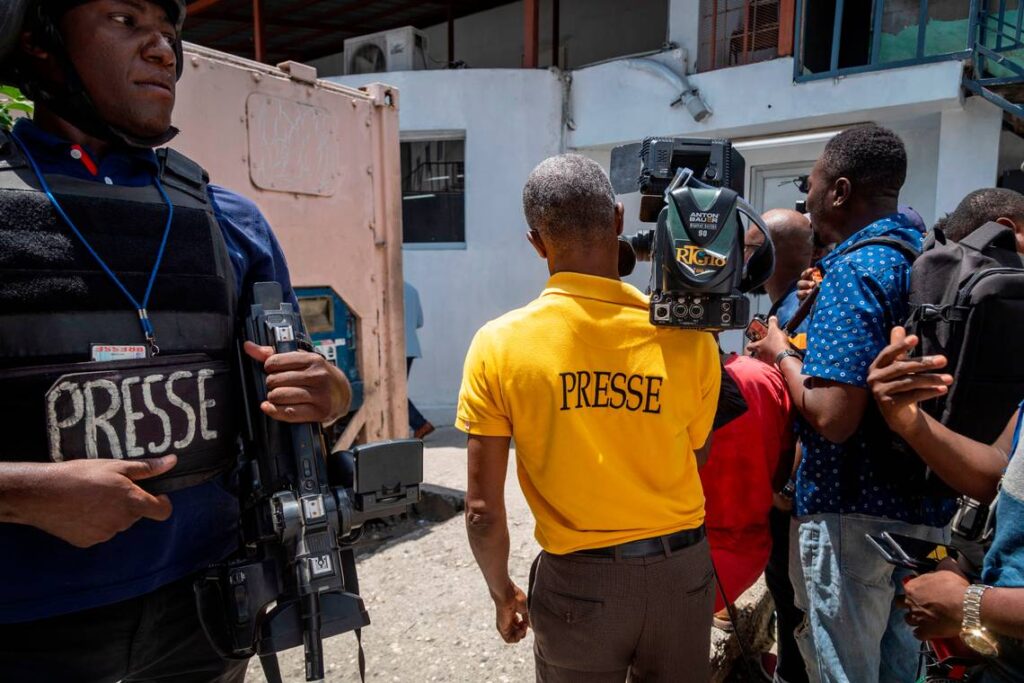PORT-AU-PRINCE — The Western Hemisphere ranks among the most dangerous places in the world for journalists, according to the Committee to Protect Journalists.
The killings of two journalists in Haiti and five in Mexico last year are among the deaths being singled out by the journalists’ protection organization that’s classifying 2024 as the deadliest year on record for journalists.
At least 124 journalists and media workers across 18 countries were killed last year, nearly two-thirds of them Palestinians who were killed by the Israeli military, the committee said. The deaths represent a 22% increase from 2023 and were largely driven by the Israel-Gaza war, which accounted for the deaths of 85 journalists, all at the hands of the Israeli military, the committee said; 82 of the 85 deaths were Palestinians.
The total exceeds the record high of 117 in 2007 when the Iraq war led to almost half of the casualties.

Haitian Journalists in August 2024 wait for then-Haitian Prime Minister Garry Conille to arrive at Bernard Mevs Hospital to visit wounded policemen. Months later, Conille would be replaced and the hospital burned and pillaged by armed gangs. (Miami Herald photo by: Jose Iglesias)
“Today is the most dangerous time to be a journalist in CPJ’s history,” said committee CEO Jodie Ginsberg. “The war in Gaza is unprecedented in its impact on journalists and demonstrates a major deterioration in global norms on protecting journalists in conflict zones, but it is far from the only place journalists are in danger. Our figures show journalists under attack worldwide.”
In the case of Haiti, the organization highlighted the country’s continued lawlessness, which has led to a four-year string of journalist fatalities since the 2021 assassination of the country’s president, Jovenel Moïse, pushed the Caribbean nation to the brink of anarchy and deepened a political crisis. Eleven journalists have been killed since Moïse’s death.
The journalists killed in Haiti last year were Jimmy Jean and Mackendy Nathoux. The two were killed on Christmas eve when armed gangs opened fire on the courtyard of a wing of the country’s largest public hospital, Hospital of the State University of Haiti, better known as the General Hospital, in Port-au-Prince, as they attended a press conference on the hospital’s reopening. At least one police officer was also killed and seven other journalists were seriously injured.
Most of the journalists worked for online media. The health minister in charge at the time was subsequently fired, but questions remain about what protections had been put in place beforehand to secure the space.
“While gang killings are common in Mexico and Haiti, Haiti’s lawlessness sets it apart as gangs now openly claim responsibility for journalists killings,” the committee said.
Gang killings are not the only threat to journalists in Haiti. In 2022, the lifeless and mutilated body of Garry Tesse, a radio journalist , was found in the town of Foco, near the city of Les Cayes, days after he disappeared.
In June, then-Prime Minister Garry Conille took the decision with his Justice Minister Carlos Hercule to put federal prosecutor Ronald Richemond on leave pending the conclusion of a criminal investigation into the allegations that he instigated Tesse’s killing. Richemond, however, remained protected from prosecution.
On Tuesday, Richemond was formally dismissed by Haitian authorities, a move that was applauded by the organization SOS Journalists in Port-au-Prince.

Haitian journalists in Port-au-Prince set up for a press conference at a local hospital. (Miami Herald photo by: Jose Iglesias)
“SOS Journalists demands that Ronald Richemond be duly arrested and tried by the competent authorities,” the group, led by journalist Joseph Guy Delva, said in a statement.
In Mexico, a period of relative calm was shattered with the killing of five journalists as gangs and political groups clashed ahead of the June 2024 election. The country has consistently ranked as one of the world’s most dangerous countries to be a journalist, the committee said, reiterating calls, along with Amnesty International, for Mexican authorities to strengthen federal protections for journalists.
‘In Mexico, culprits can remain in the shadows for years,” the committee said.
The organization also documented deaths in Sudan, Pakistan, Syria, Myanmar and Iraq, all of which represent the top deadliest places after Gaza and Lebanon. At least 24 journalists worldwide were killed because of their work, the committee said, highlighting the murder of 27-year-old Palestinian journalist Ismail Al Ghoul. Ghoul, who was working for Al Jazeera Arabic TV channel, was killed in July with his colleague Rami Al Refee, by an Israeli drone strike on their car.
In a July 31 statement, the news service Al Jazeera described the murders as “part of a systematic targeting campaign against the network’s journalists and their families,” the committee noted, while also criticizing Israel’s labeling of Ghoul as a Hamas operative without concrete evidence.
“The tactic of smearing journalists as terrorists without providing evidence is one increasingly adopted by both authoritarian regimes and supposedly democratic countries alike, and is an issue that the journalism group has called repeatedly on the international community to address,” the committee said in its release.
Ginsberg said the killings are part of a broader trend of muzzling the media globally.
“This is an issue that should worry us all,” he said, “because censorship prevents us from addressing corruption and criminality, and from holding the powerful to account.”
By JACQUELINE CHARLES/Miami Herald



